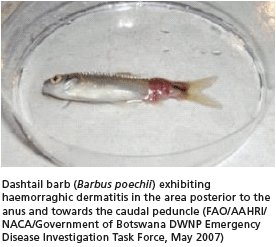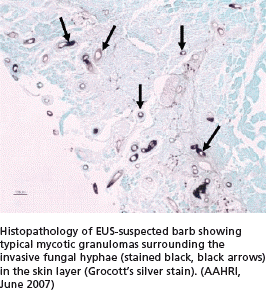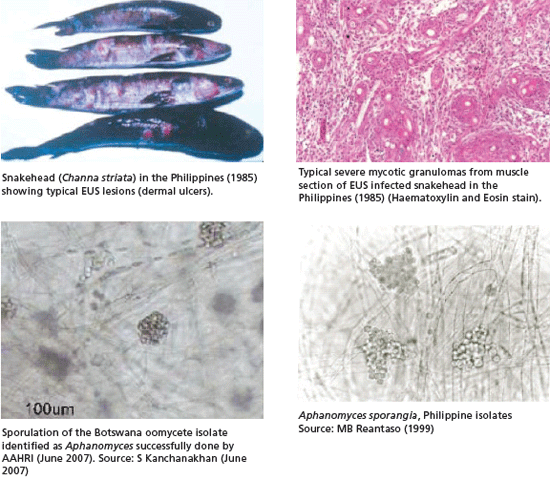Development/Emerging Issues
FAO/AAHRI/NACA investigates EUS in the Chobe-Zambezi River affecting several countries in Africa
 The FAO/AAHRI/NACA/Botswana Department of Wildlife and Natural Parks Emergency Disease Investigation Task Force
was organized by FAO in April 2007 at the request of the Government of Botswana for technical assistance in
dealing with a serious outbreak of fish disease in the Chobe-Zambezi River system. The Task Force members
included experts from FAO (Rome, Italy), Thailand Department of Fisheries Inland Aquatic Animal Health
Research Institute (AAHRI - also the OIE Reference Laboratory for Epizootic Ulcerative Syndrome - based in
Bangkok, Thailand) and the Network of Aquaculture Centres in Asia-Pacific (NACA). The overall objective of
the Emergency Task Force was to undertake an emergency assessment of the fish disease outbreak through:
(a) field observations (e.g. field visit to affected river system, interviews with local/district
officials and local fishermen, collection of epidemiological data), (b) laboratory examination (i.e.,
The FAO/AAHRI/NACA/Botswana Department of Wildlife and Natural Parks Emergency Disease Investigation Task Force
was organized by FAO in April 2007 at the request of the Government of Botswana for technical assistance in
dealing with a serious outbreak of fish disease in the Chobe-Zambezi River system. The Task Force members
included experts from FAO (Rome, Italy), Thailand Department of Fisheries Inland Aquatic Animal Health
Research Institute (AAHRI - also the OIE Reference Laboratory for Epizootic Ulcerative Syndrome - based in
Bangkok, Thailand) and the Network of Aquaculture Centres in Asia-Pacific (NACA). The overall objective of
the Emergency Task Force was to undertake an emergency assessment of the fish disease outbreak through:
(a) field observations (e.g. field visit to affected river system, interviews with local/district
officials and local fishermen, collection of epidemiological data), (b) laboratory examination (i.e.,
 parasitology, bacteriology, histopathology, mycology, virology) of available affected fish samples, and (c)
examination of available reports and other laboratory findings - to identify as far as possible the causative
agent of the outbreak, to provide recommendations to prevent further spread of the disease, recommend control
measures if applicable and develop an emergency response and contingency plan for future outbreaks to concerned
governments. Three members of the Emergency Disease Investigation Task Force (MB Reantaso of FAO, S Kanchanakhan
of AAHRI and CV Mohan of NACA) traveled to Botswana from 18-26 May 2007 to conduct an emergency investigation.
AAHRI conducted the laboratory analysis from field samples collected by the Task Force. EUS in the Chobe-Zambezi
River system was confirmed as an outcome of the Task Force investigation based on internationally accepted
diagnostic procedures for EUS. As far as is known, this is the first confirmed case of this serious disease
in the African region. Official notification was submitted to OIE by Botswana CVO in July 2007. An FAO Regional
Technical Cooperation Programme (TCP/RAF/3111 [E]) Emergency assistance to combat EUS in the Chobe/Zambezi River
has been approved for implemention from October 2007 to September 2008 involving 7 countries (Angola, Botswana,
Malawi, Mozzambique, Namibia, Zambia and Zimbabwe). The emergency assistance consist of training key
staff in the 7 countries on basic aquatic animal health management, EUS diagnosis, targeted surveillance
for EUS, preparation of an educational and extension manual, a regional strategy and a regional proposal
aimed at establishing medium-to long-term aquatic biosecurity to include as a priority an emergency
preparedness response to aquatic disease epizootics and over-all strengthening of human and institutional
capacities for fish health management that will be submitted for donor funding.
parasitology, bacteriology, histopathology, mycology, virology) of available affected fish samples, and (c)
examination of available reports and other laboratory findings - to identify as far as possible the causative
agent of the outbreak, to provide recommendations to prevent further spread of the disease, recommend control
measures if applicable and develop an emergency response and contingency plan for future outbreaks to concerned
governments. Three members of the Emergency Disease Investigation Task Force (MB Reantaso of FAO, S Kanchanakhan
of AAHRI and CV Mohan of NACA) traveled to Botswana from 18-26 May 2007 to conduct an emergency investigation.
AAHRI conducted the laboratory analysis from field samples collected by the Task Force. EUS in the Chobe-Zambezi
River system was confirmed as an outcome of the Task Force investigation based on internationally accepted
diagnostic procedures for EUS. As far as is known, this is the first confirmed case of this serious disease
in the African region. Official notification was submitted to OIE by Botswana CVO in July 2007. An FAO Regional
Technical Cooperation Programme (TCP/RAF/3111 [E]) Emergency assistance to combat EUS in the Chobe/Zambezi River
has been approved for implemention from October 2007 to September 2008 involving 7 countries (Angola, Botswana,
Malawi, Mozzambique, Namibia, Zambia and Zimbabwe). The emergency assistance consist of training key
staff in the 7 countries on basic aquatic animal health management, EUS diagnosis, targeted surveillance
for EUS, preparation of an educational and extension manual, a regional strategy and a regional proposal
aimed at establishing medium-to long-term aquatic biosecurity to include as a priority an emergency
preparedness response to aquatic disease epizootics and over-all strengthening of human and institutional
capacities for fish health management that will be submitted for donor funding.
Disease Investigation of Pearl Oysters in Australia
The pearling industry forms the most valuable aquaculture industry in Western Australia and is a major rural employer. The pearling grounds are remote, extend from Exmouth Gulf in the west to the Northern Territory border in the east, a linear distance of some 1750 km. Exmouth is 1130 km from Perth, the capital and major population centre from Western Australia. The industry is regulated, and a complex series of legislative protocols cover hatchery biosecurity and health certification prior to translocation. Despite these controls, in October 2006 severe mortalities were reported from pearl oyster (Pinctada maxima) farms in the Exmouth Gulf. The gross signs included mantle retraction, muscle weakness, mild oedema and mortality. Only P. maxima were affected, other bivalves including P. margaretifera (black pearl oysters) were healthy. Initial investigations ruled out algal blooms, starvation, environmental changes and bacterial infection. Epidemiology indicated that the mortality was due to an infectious process. Gross appearance of affected oysters showed mild oedema, retraction of the mantle, weakness and death. Histology revealed no inflammatory response, and a very subtle lesion involving tissue oedema and oedematous separation of epithelial tissues from underlying stroma. To date (August 2007) no disease agent has been identified, though research is continuing.
